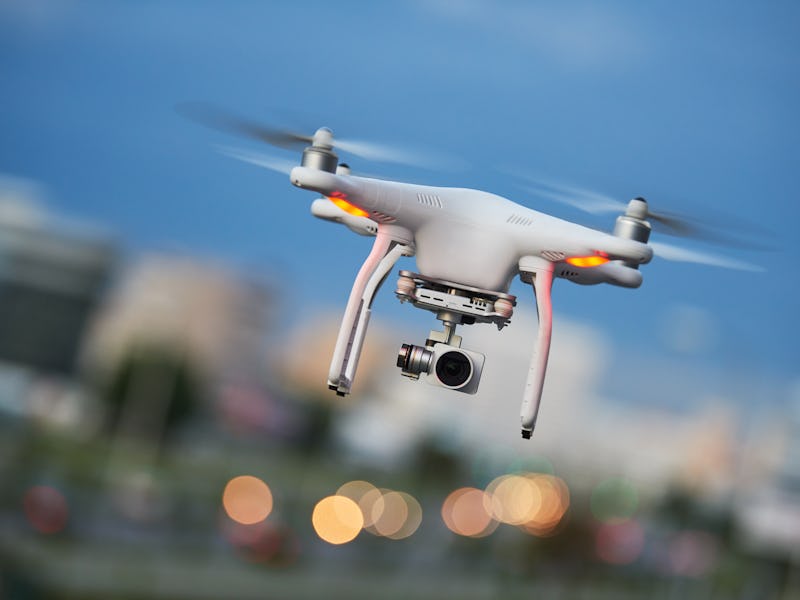Bat-like echolocation could help drones see the world
Scientists say that that approach could be used for cars and robots too.

Despite their growing technical abilities and intelligence, machines still struggle to see the world the way humans do. Even navigating their way through an empty room can pose a challenge. But scientists have now demonstrated how a drone might be able to use bat-like echolocation to better see and navigate its way through an unknown room.
The study, published Thursday in the journal SIAM Journal on Applied Algebra and Geometry, used a mathematical model to investigate how a drone could use the reflection of sound waves to pinpoint the location of different walls in a room. In order to do this, the authors imagined a scenario in which a loudspeaker is placed in a room and a drone, placed randomly in the room, was outfitted with four microphones.
Mireille Boutin, the paper's co-author and associate professor of mathematics and electrical and computer engineering at Purdue University, said in a statement that this configuration allowed for the drone to measure the time it takes for a sound to be bounced back to it from a wall and begin to determine its own distance from the wall and the configuration of the walls in the room.
"The microphones listen to a short sound impulse bouncing on finite planar surfaces -- or the 'walls,'" said Boutin. "When a microphone hears a sound that has bounced on a wall, the time difference between the emission and reception of the sound is recorded. This time difference corresponds to the distance traveled by the sound during that time."
The drones are able to do this by imagining the sound data as coming from a virtual point beyond the actual walls of the room instead of a single speaker. Then, using these virtual points, the drone is able to compare the distance of its microphones to the virtual source and reconstruct what would be four different points of the actual wall.
"If we know the distance from one of these virtual source points to each of the four microphones, we can recover the coordinates of the virtual source and subsequently reconstruct four points on the wall -- and hence the plane that contains the wall," said Boutin.
After that information is collected the authors used an echo sorting algorithm in order to determine "wall assignment," or, to tell one wall apart from another.
In models where the microphones were not attached to a drone, it might be possible to accidentally detect 'ghost' walls as well as 'real' walls.
The authors write in the paper that this approach, including echo sorting and attaching microphones to the drones themselves, helps eliminate a problem they ran into in previous models: detecting ghost walls. When microphones were placed around the room instead of at a single point on the drone, the authors saw that it would be possible for the reflection of the sound waves to appear to bounce back from an imaginary source in the room. This could lead the drone to incorrectly believe that there existed another ghost wall in the room and lead it to incorrectly visualize the room.
While this study was theoretical, the authors write that it demonstrates how such technology could be successfully used in practice and that additional information wouldn't be necessary in order to visualize these walls. The authors also write that such an approach could be used beyond drone technology. "These microphones can be placed inside a room or on any vehicle, such as a car, an underwater vehicle, or a person's helmet," Gregor Kemper, a professor in the Department of Mathematics at Technische Universität München, said in the team's press statement.
"A moving car is different from a drone or an underwater vehicle in an interesting way," Kemper says. "Its positions have only three degrees of freedom--x-axes, y-axes, and orientation--whereas a drone has six degrees of freedom. Our work indicates that these six degrees of freedom are sufficient to almost always detect the walls, but this does not necessarily mean that three degrees will also suffice. The case of a car or any surface-based vehicle is the subject of ongoing research by our group."
Abstract: We show that one can reconstruct the shape of a room with planar walls from the fi rst-order echoes received by four non-planar microphones placed on a drone with generic position and orientation. Both the cases where the source is located in the room and on the drone are considered. If the microphone positions are picked at random, then with probability one, the location of any wall is correctly reconstructed as long as it is heard by four microphones. Our algorithm uses a simple echo sorting criterion to recover the wall assignments for the echoes. We prove that, if the position and orientation of the drone on which the microphones are mounted do not lie on a certain set of dimension at most 5 in the 6-dimensional space of all drone positions and orientations, then the wall assignment obtained through our echo sorting criterion must be the right one and thus the reconstruction obtained through our algorithm is correct. Our proof uses methods from computational commutative algebra.